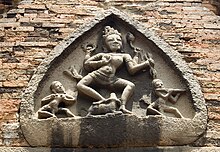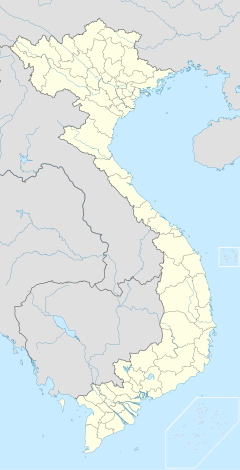Po Nagar
| Po Nagar | |
|---|---|
Khanh Hoa | |
| Deity | Yan Po Nagar |
| Location | |
| Location | Nha Trang |
| Country | Vietnam |
| Geographic coordinates | 12°15′55″N 109°11′44″E / 12.26528°N 109.19556°E |
| Architecture | |
| Type | Champa |
| Completed | mid-10th to 13th century[1] |
Po Nagar is a
History
A
The Cham military leader Senapati Par, under the reign of Harivarman I, made endowments in 817. Senapati made attacks on the Khmers under Jayavarman II. Harivarman I was succeeded by his son, Vikrantavarman III, who also made endowments.[2]: 104
A
In the 17th century, the Vietnamese people occupied Champa and took over the temple tower, calling it Thiên Y Thánh Mâu Tower.[6] A number of Vietnamese legends regarding the goddess and the tower have come into being.
Site

The Po Nagar complex is situated on Cù Lao Mountain. It consists of three levels, the highest of which encompasses two rows of towers. The main tower is about 25 m high.[7]

The temple's central image is a 1.2m tall stone statue of the goddess Yan Po Nagar sitting cross-legged, dressed only in a skirt, with ten hands holding various symbolic items. According to Vietnamese scholar Ngô Vǎn Doanh, these attributes show that Yan Po Nagar was identified also with the
See also
References
- ^ estimates by Trần Kỳ Phương (Tran 2009, 182)
- ^ ISBN 978-0-8248-0368-1.
- ^ Ngô Vǎn Doanh, Champa: Ancient Towers, p.192.
- ^ ISBN 9789747534993
- ^ Ngô Vǎn Doanh, Champa: Ancient Towers, p.192 f.
- ^ Ngô Vǎn Doanh, Champa: Ancient Towers, p.198.
- ^ Ngô Vǎn Doanh, Champa: Ancient Towers, p.209 ff.
- ^ Ngô Vǎn Doanh, Champa: Ancient Towers, p.194 f., 212 f.
- ^ Ngô Vǎn Doanh, Champa: Ancient Towers, p.215.
- Bibliography
- Coedès, George, The Indianized States of Southeast Asia. Honolulu: East-West Center Press, 1968.
- Ngô Vǎn Doanh, Champa: Ancient Towers. Hanoi: The Gioi Publishers, 2006. Chapter 14: "Po Nagar Tower: The Temple of the Goddess of the Country," pp. 187 ff.
- Trần Kỳ Phương (2009): The Architecture of the Temple-Towers of Ancient Champa. in Hardy, Andrew et al. (ed): Champa and the Archaeology of Mỹ Sơn (Vietnam). NUS Press, Singapore

